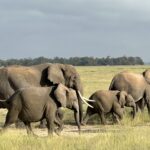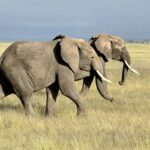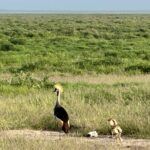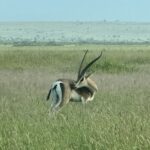Aurogra for sale without prescription We grabbed a cup of coffee to be ready to meet George at 6:30 AM. He had arranged with Tawi Lodge to get our breakfast-to-go. Our goal was to get to the park early to catch a glimpse of as many animals as possible!
Right out of the gate, we caught sight of a lion. He didn’t stick around to pose for us.

Male Lion
Lions are the largest terrestrial predator in Africa, but usually the most sociable but the least secretive. The lion we saw was alone as far as we could tell though they usually live in a pride of 5 or so animals usually consisting of an adult male, a few females, and any offspring. It seldom takes to trees, and an adult male sports a regal black or blond mane. Those lions in reserves or parks are protected but lions elsewhere are in decline. Lions can spend up to 20 hours a day at rest, are seldom active in the heat of the day, but can cover great distances at night. Prides have been known to defend their territory between 8 and 77 square miles. Females in a pride usually give birth more or less simultaneously. Females usually stay with their birth pride, but young males are forced out by the dominant male when they reach maturity. Our fleeting lion sighting was over quickly but hopefully there will be other opportunities.
Shortly after the lion retreated into the brush, we saw giraffes running away in the opposite direction.
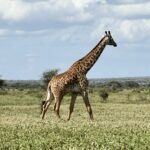
Maasai Giraffe
Giraffes are easy to spot in the wild since they are the tallest mammal. Giraffes are very common in most of Kenya’s national parks. The giraffes here In Amboseli are the Maasai variety. The Maasai giraffe has ragged spots on a yellow-fawn coat. Giraffes typically move around in groups of 10 to 15 animals. The group we saw only consisted three. We fabricated a story that they were running away from the lion we saw earlier. Herds usually are Impermanent meaning they can join and leave at will. They also may be all male or all female or mixed. Males are significantly larger in size than females. Females normally have one calf or occasionally twins and give birth standing, allowing the newborn to drop up to 7 feet to the ground. The calf gets up on his feet immediately and might start suckling within 30 minutes. The giraffe is a highly specialized canopy feeder, browsing on high-grade leaf foliage at heights of up to 20 feet, although it will occasionally eat grass as well. They strongly favor Acacia‘s leaf structure. The combination of their long neck and versatile tongue allows a giraffe to reach, leaves that no other species can. It mostly feeds in the early morning and late afternoon, retiring in the shade to chew the cud during the hotter hours of the day.
Next we came in a herd of elephants consisting of multiple clans. They had spent the night over toward Mt Kilimanjaro and were preparing en masse to cross the road to head to the swamp/marshland. The elephant is the world’s largest mammal with imposing bulk. Elephants are notable for two unique adaptations – along trunk that combines strength with the sensitivity to isolate and tear out a single blade of grass, and outside tusks that grow throughout its life, sometimes reaching lengths in excess of 10 feet. They have a complex social behavior. Females and youngsters usually move around in close-knit matriarchal clans. Sisters often have their own clan within the herd. Adult females maintain a vigilant watch over the young until they are old enough to deter predators. We saw many youngsters actually walking under their mother’s or aunt’s feet. Calves are often raised communally. Elephants have an exceptional sense of smell, and good eyesight. Researchers in Amboseli National Park, discovered that the elephants main means of communication consists of subsonic rumblings well below, or at the very edge of human perception that can travel through the Earth for several miles. These sounds are picked up by the skin on the trunk and feet, allowing dispersed herds to coordinate their movements over a vast area. Elephants flap their ears to cool their skin.
Once the elephants had crossed the road, we continued on to the national park airport, or actually just a tarmac, short runway, to eat our breakfast that George brought from the lodge. Of note, is that we will be flying out of that airport tomorrow. On the way, we saw flocks of flamingoes. We had fruit, yogurt, a small pancake, a breakfast sandwich, juice, and assorted tasty bites.
George took us to see Amboseli Lake, pretty much dry in the dry season. We were able to see some water since it had rained the week before. Maps of the park show Lake Amboseli as a vast blue tract covering much of the parks western third. In reality the lake has only filled with water on a few occasions in the past century, more often it is a barren expanse of clay swept across by swirling armies of dust, devils, and the occasional herd of wildebeest or zebra.
We saw dozens of birds along the way and Kimberly Baker has a list of them.
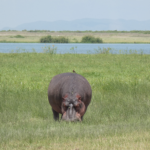
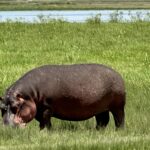 We saw a hippopotamus beside the road, chewing on grass next to a body of water by observation hill. Hippos have purple, gray, hairless, hide, with pink underside and cheeks, a barrel-like torso, and stumpy legs that render it unmistakable. Ears, eyes, and nostrils are placed high on the skull, allowing it to spend most of its time submerged in the shallows. It feeds on land, emerging between dusk and dawn to eat grass with its wide mouth. often it wanders from the water in the process. The hippo is highly gregarious, living in pods of up to 30 members, and very territorial, with fights for dominance between males, often resulting in serious injury or death. The hippo is highly mobile on land and can attain speeds above 20 miles an hour. It can be dangerous to humans as it typically heads straight to the water when disturbed mowing down anything in its path.
We saw a hippopotamus beside the road, chewing on grass next to a body of water by observation hill. Hippos have purple, gray, hairless, hide, with pink underside and cheeks, a barrel-like torso, and stumpy legs that render it unmistakable. Ears, eyes, and nostrils are placed high on the skull, allowing it to spend most of its time submerged in the shallows. It feeds on land, emerging between dusk and dawn to eat grass with its wide mouth. often it wanders from the water in the process. The hippo is highly gregarious, living in pods of up to 30 members, and very territorial, with fights for dominance between males, often resulting in serious injury or death. The hippo is highly mobile on land and can attain speeds above 20 miles an hour. It can be dangerous to humans as it typically heads straight to the water when disturbed mowing down anything in its path.
We headed back to lodge, seeing animals we’d seen before, to grab a bite of lunch, arriving after 1 pm. Then a short period of rest before heading out to a sundowner with George in the late afternoon.
At 5 pm, we waited in the lobby for our sundowner organizer to come meet us. We found out that the 15 minute walk to meet up with George was a 50 minute nature walk through the plains outside the lodge. Patrick was our guide and was very informative about what we encountered from skat/dung, to hoof prints, to the toothbrush tree, and desert basil which the Maasai use as a broom to sweep their floor and give the house a pleasant basil smell. We saw a termite mound (inactive) so it was probably inhabited by a mongoose and a snake in their separate chambers. After walking around the field, picking up burrs on our socks, we found George and Tom. They had set up the perfect spot to view Mt Kilimanjaro and the sunset. We enjoyed the wine and snacks they provided and shared them with them. Among the munchies were Kenyan cashews, bigger than ones we get in the US and plainly roasted. Once the sun had set, George drove us back to Tawi. After a quick refresh, we enjoyed a BBQ provided by Tawi Lodge.
Then off to pack and bed, since breakfast is at 6 am, and we are leaving Tawi Lodge heading to our next stop
Manouba Kenya Birds Amboseli
Amboseli National Park
Landed in Finch Haddons
Weaver birds
Masked weaver (Make nest in Acacia trees)
Lilac Breasted Roller. National bird
Hornbill
Superb starlin
Yellow neck spaffell
White headed Buffalo Weaver
Tawny Eagle
Crested cranes
Greater flamingos
Black winged stilt
African ibis
Hadeda inis
Spalling lapwing
Sand bill stork
Greater and lesser sandpipers
Egyptian geese
African Jacana
African pied avocets
Greater flamingos
Lesser flamingos
Yellow Bishop
Pied Kingfisher
Madagascar heron
Black head heron
White faced duck
African starlings
Crowned plover
Kitrich
White pelicans
African spoonbills
Red billed Oxbird
African fish eagle
Swifts
Swallows
Elephant Egret
Double band course
African doves
Common shrike
White head full
White head pelican
African pied wagtail
Superb starling
Tropical Boubou
African fire finch
Augur Buzzard

